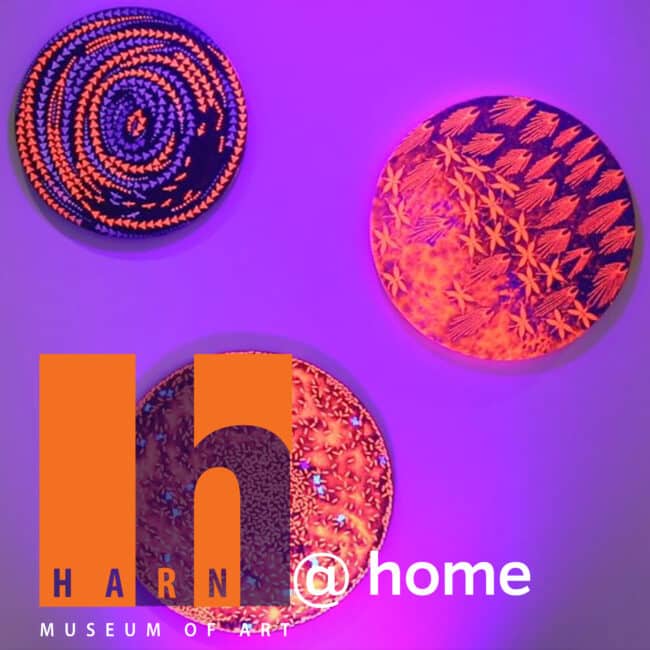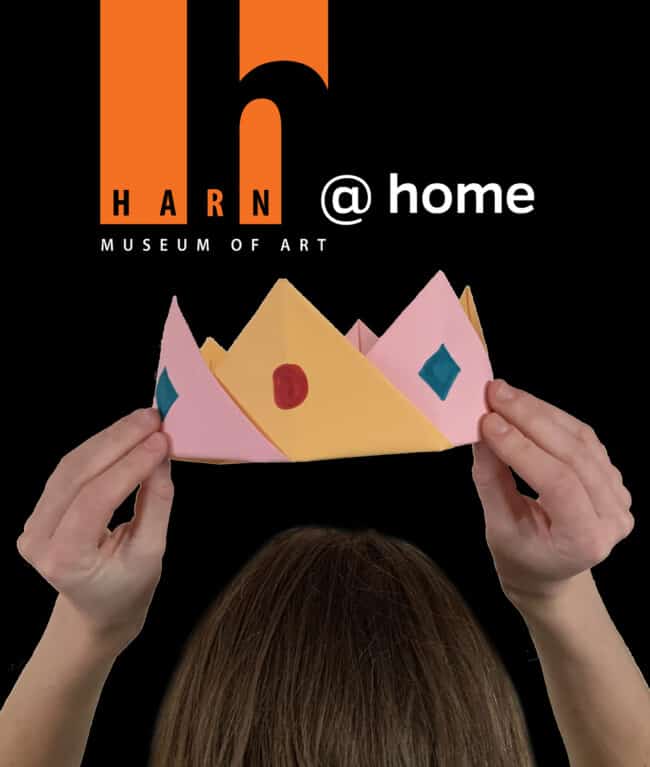Watch the video to discover the art of mending and to examine differing views on breakage and perfection. In the Banyankole and Banyarwanda Vessel with Lid (inkongoro with umutemeri) and the Japanese Incense container (Kogo), cracks are mended with metal. On both objects, light reflects off the metal, creating strong contrasts between the metal and the objects’ dark surfaces. The Banyankole and Banyarwanda peoples prefer unblemished vessels while Japanese culture celebrates breakage. Drawing inspiration from these repaired objects, follow the instructions to practice the art of mending to create your own interesting designs that may influence your views on damage and repair.
What You’ll Need
- Black paper
- Black drawing and painting utensils
- Household metal items such as fasteners, paperclips, wire, safety pins and aluminum foil
- Metallic markers or paint
- Scissors
- Glue
What You’ll Do
1. Paint or draw in black onto your piece of paper to create a subtle image or design.
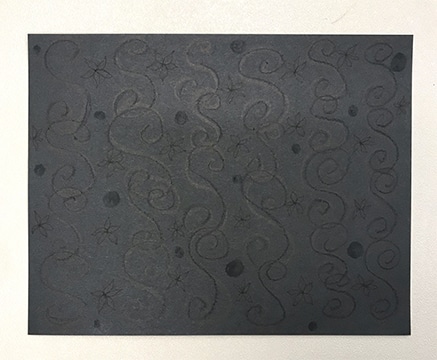
2. Rip, tear or puncture your decorated piece of paper into one or more pieces.
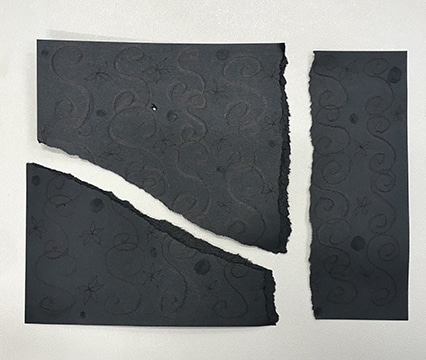
3. Reflecting on the ways in which the African metalsmith repairs the milk vessel and the Japanese artist practices kintsugi, mend your broken artwork using a variety of metallic materials.
Tips:
- Call attention to the ripped, torn and punctured paper by applying metallic markers or paint to the edges of the paper fragments.
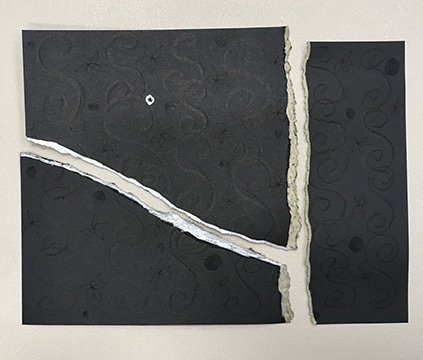
- Repair the piece of paper using metal fasteners, safety pins, paperclips, wire, etc.
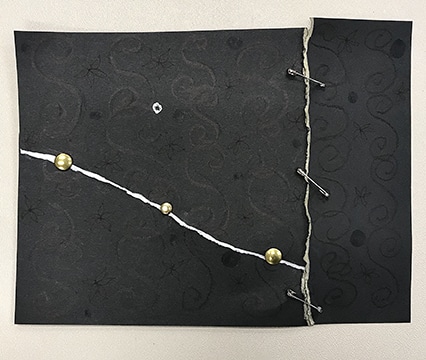
- Cut the aluminum foil into a variety of shapes then glue them in interesting patterns along the seams to mend your piece of paper.

4. Admire your transformed work of art!
- Notice how the metal reflects light and contrasts with the black background.
- Explore the different textures that have been added to the paper.
- Do you think these repairs enhanced your artwork?
- Did you like your artwork better before it was ripped and repaired? Or do you like your artwork now that it’s mended?
- Has your mended artwork, as well as the Vessel with Lid and Incense container, influenced your perspective on breakage, failure or repair?
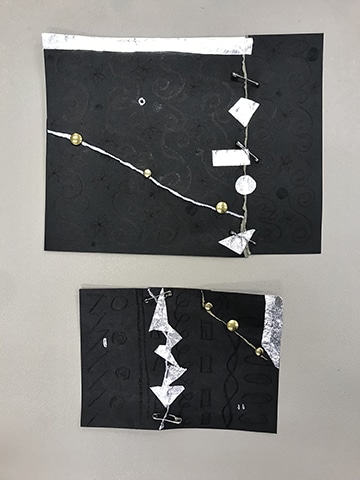
Tips & Tricks
- Try repeating this activity with paper and drawing materials of different colors. Instead of using metallic paint and markers to call attention to the ripped, torn and punctured paper, try using a paint or marker color that contrasts with the color of your paper, such as red marker on green paper. How do the metal repairs interact with the other colors you included in your artwork? Do the repairs stand out or do they blend in with the colors and designs on your paper?

- Now that you have mended your decorated piece of paper, look for broken objects in need of repair. How will you mend the object? Will you try to conceal its imperfections? Or will you try to highlight them?
Object Connection
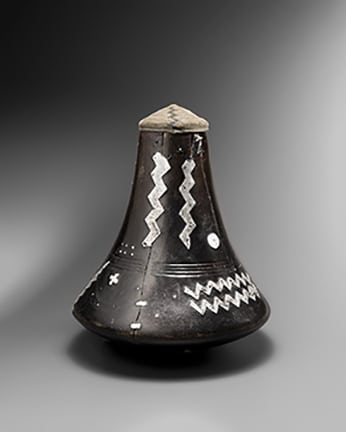
Carved from wood, topped with a fibrous lid, and repaired with metal patches, this type of vessel serves a functional as well as a social role in the lives of the Banyankole or Banyarwanda peoples. To make these lidded vessels, Banyankole men carve the vessels out of wood, while Banyankole or Banyarwanda women weave the cone-shaped lids out of fibers. The vessels function to collect, store and serve milk. At wedding ceremonies, the husband’s family gifts the bride with cows who are each accompanied by its own vessel. Metalsmiths repair cracks that occur on the vessels with patches of silver alloy, tin, or aluminum. These patches take various shapes, including zigzags, circles and crosses. On this vessel, you can see the metal patches starkly contrast with the dark wood of the vessel as light reflects off their surfaces. Though decorative in appearance, these metal patches are considered unsightly to the Banyankole and Banyarwanda who prefer unblemished vessels.
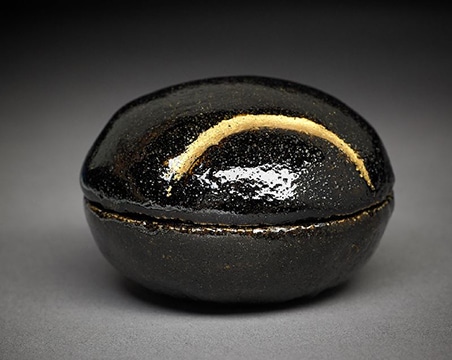
This small, ceramic container is used to store incense. On the container’s lid, a streak of gold catches the attention of the viewer and user of the Kogo. Like the metal patches on the African vessel, this gold detail greatly contrasts with the dark surface onto which it has been placed. The gold line is reminiscent of the Japanese practice of kintsugi. In this practice, broken or irregular objects are mended with lacquer mixed with powdered gold to emphasize and beautify the object’s imperfections. As time passes, inevitable breakage is treated as a part of the history of an object and is considered something to be celebrated.
Lesson Plan by Sarah Bass, Family Programs Intern & 4th-year Art and Art History major in UF’s College of Art School of Art and Art History

